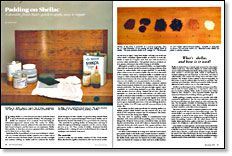Padding on Shellac
A durable finish that's quick to apply, easy to repair
Synopsis: Jeff Jewitt says padding shellac is a low-tech process that is perfectly suited to the professional ad amateur finisher. Advantages are numerous, and the method is easy to master. He rubs on a freshly dissolved shellac solution over a sealer coat of oil, which increases the finish depth. Here, he explains what materials you’ll need, what shellac is and how it’s commonly used, the preparation steps you need to take, oiling, and then padding the finish. Rubbing out the finish results in a smoother, better-looking surface, he says. Jewitt also explains how to maintain the finish.
Padding shellac is a low-tech process that is perfectly suited to the professional and amateur finisher. The advantages of shellac are numerous. It is a nontoxic, Food and Drug Administration-approved natural resin. The carrier for shellac, ethanol, is relatively nontoxic (ethanol is the same kind of alcohol that’s found in liquor), and the fumes are not unpleasant. Shellac dries quickly, so dust does not pose a great problem, and finishes can be done in two to three days.
Applying shellac by padding it on is an easy technique to master. I rub on a freshly dissolved shellac solution over a sealer coat of oil, which increases the finish depth. I let each coat dry overnight and continue rubbing on shellac until I’ve achieved the desired depth and gloss I’m after. Shellac is a good-looking, durable finish that can easily be repaired if damaged. But because shellac can be dissolved by alcohol, this finish is not a good choice for a bar top.
The materials for padding shellac are inexpensive and easy to obtain through most finishing companies. They consist of shellac, denatured alcohol, padding doth, a drying oil such as boiled linseed oil or tung oil, sandpaper and synthetic steel wool.
The materials
I prefer to make my own shellac solution of 2 lbs. of dry shellac flakes dissolved in a gallon of alcohol (a 2-lb. cut; for more on this, see the story at right). Using fresh shellac will help you avoid one of the classic complaints against shellac as a finish—it won’t dry. Shellac is made up of organic acids that react with alcohol in a process called esterification. This gradual reaction produces esters, gummy substances that inhibit drying in old shellac.
Although it’s possible to use premised shellac, any liquid shellac older than six months should be tested for drying problems (Wm. Zinsser Co. makes shellac with a longer shelf life). To test shellac, place a drop or two on a piece of glass. If it’s not dry to the touch in five minutes, don’t use it. Premixed shellac is available only in orange or white (chemically bleached) varieties; there are more choices if you buy it in dry form (see the photo above). And if you mix your own shellac, you are guaranteed a fresh solution.
From Fine Woodworking #112
For the full article, download the PDF below:
Fine Woodworking Recommended Products

Jorgensen 6 inch Bar Clamp Set, 4 Pack

Bumblechutes Bee’Nooba Wax

Olfa Knife






















Log in or create an account to post a comment.
Sign up Log in